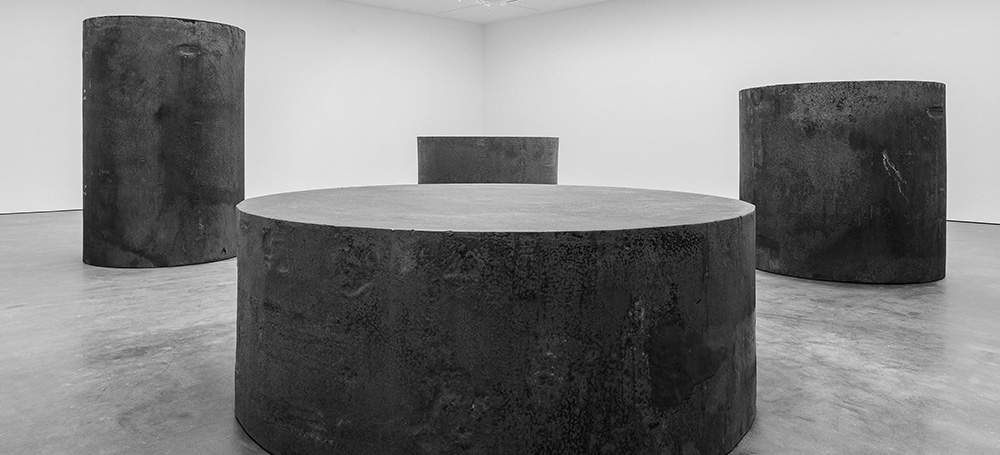ART CITIES:N.York: Richard Serra
 One of the preeminent sculptors of our era, Richard Serra, has long been acclaimed for his challenging and innovative work, which emphasizes materiality and an engagement between the viewer, the site, and the work. In the early ‘60s, Serra and the Minimalist artists of his generation turned to unconventional, industrial materials and began to accentuate the physical properties of their art.
One of the preeminent sculptors of our era, Richard Serra, has long been acclaimed for his challenging and innovative work, which emphasizes materiality and an engagement between the viewer, the site, and the work. In the early ‘60s, Serra and the Minimalist artists of his generation turned to unconventional, industrial materials and began to accentuate the physical properties of their art.
By Efi Michalarou
Photo: David Zwirner Gallery Archive
Two major new works in forged steel by Richard Serra are on presentation at David Zwirner Gallery in New York also recent drawings by the artist are on view in the gallery’s second floor exhibition spaces. According to Serra, the foundations of his work took shape on his fourth birthday, during the launch of an oil tanker at the Marine Shipyard in San Francisco, “All the raw material I needed is contained in the reserve of this memory”. In 1966 he moved to New York. There he met other future Minimalists and Environmental Artists such as: Eva Hesse, Carl Andre, Donald Judd, Bruce Nauman, Steve Reich, Robert Smithson, and Michael Snow. In New York, he began making his first sculptures out of rubber-said to have been inspired by the horizontal progression in Jackson Pollock’s painting. In 1968 Richard Serra made his piece titled “Splashing” by throwing molten lead in the corner where the floor meets the wall in the warehouse of the art dealer Leo Castelli. His “Prop” series, which Serra began in 1969, are perhaps also the beginnings of Serra’s recall of his childhood memories of the oil tanker skimming the surface of the ocean. The “Props” were constructed by such techniques as pinning a sheet of steel to the wall with a rolled lead pipe and leaning steel sheets against each other in configurations that were held together by gravity alone. Serra’s first large commissions were mostly realized outside USA. Like: “Shift”, that was commissioned in 1970 by the art collector Roger Davidson and installed on his family property in Ontario, “Spin Out” in the Kröller-Müller Museum and “Elevation Circles: In and Out”, that was installed at Schlosspark Haus Weitmar. In 1981, Serra installed “Tilted Arc”, a gently curved, 3,5 meter high arc of rusting mild steel in the Federal Plaza in New York City. The work was commissioned by the United States General Services Administration Arts-in-Architecture program for the Foley Federal Plaza. However, after much debate, it was removed in 1989 following a lawsuit. Serra continued to produce large-scale steel structures for sites throughout the world, and became particularly renowned for his monumental arcs, spirals, and ellipses, which engage the viewer in an altered experience of space. Serra was the second artist, after Anselm Kiefer, to be invited to fill the 13,500 m² nave of the Grand Palais with works created specially for the event. In 2011, Serra unveiled his sculpture “7” in Doha, Qatar. The sculpture, located at an artificial plaza in Doha harbor. The sculpture was commissioned by the Qatar Museums Authority and took one year to be built. In March 2014, Serra’s “East-West/West-East”, a site-specific sculpture located at a remote desert location stretching more than a half-mile through Qatar’s Ras Brouq nature reserve, was unveiled. Richard Serra has created many series of drawings that, while independent of his sculptures, correspond to the founding elements of his sculptural language: time, process, and materiality. While there is an obvious relationship to his drawings as works in two-dimensions, Serra considers his prints to be distinct for their specific relation to the mechanical process. He has described drawing specifically for printmaking and how it inevitably transforms the work: “Oftentimes the spontaneity of the line is lost, or the ink will mottle or blot a form that was unintended. To understand the medium, I think you have to draw specifically for it”.
Info: David Zwirner Gallery, 537 West 20th Street, New York, Duration: 4/11-16/12/17, Days & Hours: Tue-Sat 10:00-18:00, www.davidzwirner.com
